Published
on 20
Jan 2017
|
All rights reserved.
|
|
|

|
|
Hyundai
follows Peugeot to carbon-copy the formula of Volkswagen Golf. Is it
good enough to match the class leader?
|
|
I like the last generation
i30 for its sporty, tasteful yet original styling. However, it seems
that Hyundai has changed its mind and decided to follow the footsteps
of Peugeot 308 to replicate the conservative, quality-oriented theme of
Volkswagen Golf, which is admittedly quite successful on the Peugeot.
So the second generation i30 gets boxier, with a solid shoulder line
and thick C-pillars reminiscent of Golf. Meanwhile, the Genesis-like
prominent front grille attempts to bring a premium image but it looks a
bit odd on a compact hatchback. The car
is once again designed at Hyundai's European styling center in Germany,
engineered at Russelsheim and built at Czech Republic. A lot of test
miles were clocked in the great Nurburgring Nordschleife to make sure
it drives like a European car.
Despite the boxier shape, its drag coefficient remains unchanged at
0.30, thanks in part to the active grille shutter which reduces intake
area at higher speeds. The monocoque body is now constructed with high
percentage (53%) of high-strength steel, including even stiffer
hot-stamped steel at parts of crash structure. More extensive use of
structural
adhesives also helps the monocoque to increase torsional rigidity by 22
percent, while its weight is reduced by 28 kg. Nevertheless, other
enhancement means the whole car is slightly heavier than before. It is
also heavier than the equivalent Golf, Opel Astra and particularly the
lightweight Peugeot 308.

|
|
While
it follows the industrial trend closely, it fails to break any new
grounds or introduce any innovations. |
|
The underpinning platform is an evolution from the last one. It keeps
the 2650 mm wheelbase and continues to employ suspensions consisting of
MacPherson struts up front and multi-link arrangement at the rear.
Since the foundation is stiffer, ride quality and NVH suppression
should be improved. Meanwhile, the electric power steering is geared 10
percent quicker to improve agility. While it follows the industrial
trend closely, it fails to break any new grounds or introduce any
innovations. This make it less appealing to automotive journalists and
customers seeking surprises. Unlike Golf, its essence is just as
conservative as it looks.
The same can be said to its engine lineup. All motors are up to date
enough, but none of them are worth special attention. The industrial
trend favours downsized turbocharged engines, so the Hyundai gets a
1.0-liter three-cylinder direct injection turbo. It offers a
respectable 120hp output and is accompanied with decent refinement, but
it does not feel as remarkable as the triples of Ford, Volkswagen, Opel
and PSA (though better than Renault’s), while the heavier i30 is slower
than its rivals.
Need more speed? The 1.4-liter DI turbo four-cylinder is the answer.
Naturally, it is slightly smoother than the three-cylinder, and 140
horsepower is good enough to propel the car to 60 mph in 8 and a half
seconds. Even so, the car feels brisk only if you keep pressing it. It
feels most comfortable and refined working at the mid-range though.
Besides these downsized engines, there are also two larger and older
engines on offer: 1.6 turbo diesel (136hp) and 1.6 DI turbo (204hp,
from Veloster). As we already know, they are not exactly world-class.
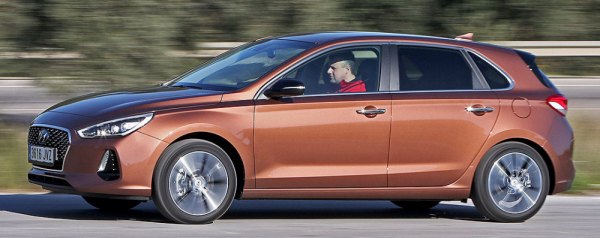
|
|
While its
chassis feels solid and the handling is predictable, it is tuned too
safe to the extent of boring.
|
|
The i30 is not a car that you would enjoy to push to the limit. While
its chassis feels solid and the handling is predictable, it is tuned
too safe to the extent of boring. The steering feels numb and the
chassis response lacks interaction with the driver. Its best asset is
cruising refinement, as its cabin is remarkably quiet and the
suspension is well damped over speed bumps. Nevertheless, the
suspension setup is too stiff for town or backroads. Again, most of its
key European rivals are more rewarding to drive.
Inside, the interior design, packaging and build quality are decent but
not good enough to shake Volkswagen, or even Peugeot or Renault Megane.
The sleek dashboard makes the cabin feel airier, but it looks a bit
flimsy and low on texture quality. The dash top is soft-touch plastics
as in most rivals, but the middle section is hard plastic, whose light
color and shiny surfaces make it feel cheaper still. The same goes for
the freestanding infotainment screen whose housing looks cheap and
fragile. We don’t doubt the fit and finish of Korean cars nowadays, but
they still need to work harder to deliver the perceived quality of
European cars. The front seats are comfortable, while the rear bench
offers just enough space for adults – providing the front occupants are
not too tall. However, the boot volume is generous for this class.
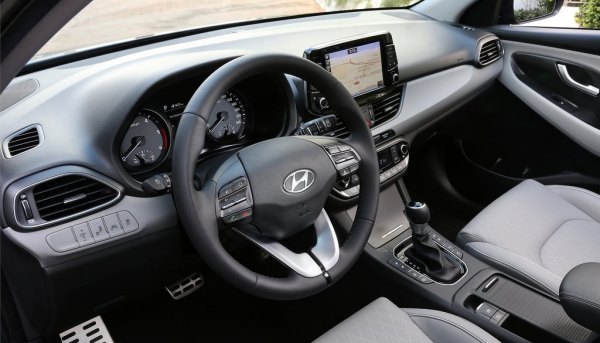 |
|
We
don’t doubt the fit and finish of Korean cars nowadays, but they still
need to work harder to deliver the perceived quality of European cars.
|
|
Disappointingly, the new i30 does not quite match the high standards of
Volkswagen Golf despite its similar looks and philosophy. It is hard to
think of any reasons to choose it instead of the sales champion.
Meanwhile, without spending enough efforts to improve its handling and
performance, it has wasted an opportunity to lure buyers from Ford,
Mazda or Opel.
|
Verdict:    |
Published
on 15
Oct 2017
|
All rights reserved.
|
|
Elantra GT and GT Sport
|
|
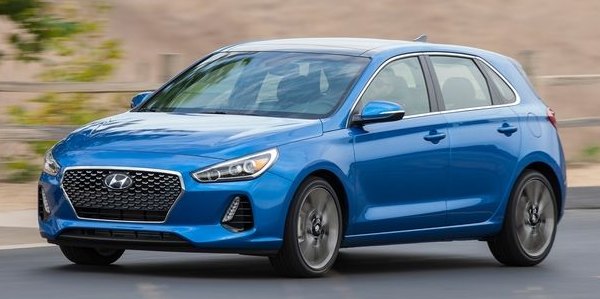
|
|
It
might be an effective way to transport you from A to B in hurry with
minimum fuss, but never puts a smile in your face.
|
|
The European-built i30 is
also exported to the North America, but with different mechanicals and
a different name, Elantra GT. The regular Elantra GT is powered by a
good old 2.0 naturally aspirated GDI engine that produces 161 hp and
150 lbft of torque. It terms of flexible power it is not going to match
the European car's 1.4 GDT engine, because its peak power is not only
lower but also arrives much later at 4700 rpm. Moreover, the engine is
not particularly sweet to stretch, emitting a loud and coarse noise at
higher revs. It can be mated with a 6-speed manual or a 6-speed
automatic, both are pretty good for its kind, but DCT is not available.
The ride and handling is fair without being remarkable. Note that for
cost saving the i30's multi-link rear axle is replaced with a torsion
beam. This simpler design fails to isolate harshness as well as
multi-links, so Hyundai opts for a softer setup here. The result is
reasonable ride comfort at the expense of body roll control.
Unsurprisingly, Elantra GT is not a driver's car. Its steering feels
vague and its handling is biased towards safe understeer, slightly more
so than the i30. The North America market is now available with many
world-class compact cars and hatchbacks, so the Hyundai will find a
hard time competing with them.
Sitting above the regular Elantra GT is the GT Sport. In fact, it is
the same car as the i30 1.6 GDT found in some European markets. This is
a "warm hatch" powered by the company's 204-horsepower 1.6 direct
injection turbo engine. It can be mated with either 6-speed manual or
7-speed DCT, but the manual is the better choice because it offers
slick gearshifts and a smooth clutch engagement for pretty good fun.
Unfortunately, Hyundai's 1.6 GDT engine remains better on paper than in
the real world. It lacks the sweet revving manner and flexibility of
many other warm hatches, let alone a melodic sound (though not many
managed to do so). Multi-link axle is back to the car, and its
suspension tuning is slightly sportier than the regular car.
Nevertheless, like the rest of the i30 range, it is more about solid
chassis and abundant grip. The rear axle never listens to throttle, and
the steering doesn't talk with you. It might be an effective way to
transport you from A to B in hurry with minimum fuss, but never puts a
smile in your face.
|
Verdict:    |
Published on 15
Oct 2017
|
All rights reserved.
|
|
i30N
|
|
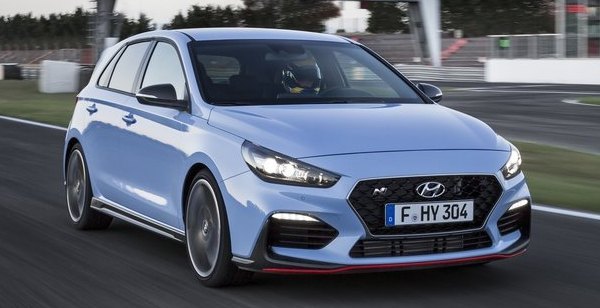
|
|
From
M to N: Hyundai hired the boss of BMW M to head its N performance
brand. Can he repeat the magic?
|
|
In the past 2 decades,
Hyundai has risen from an economy car manufacturer to a superpower in
the same breath as Toyota or Volkswagen. Its wide range of cars cover
as low-end as i10 to as high-end as Genesis G90. More recently it also
begins to inject a sport premium flavor into its cars, resulting in Kia
Stinger and Genesis G70. The last piece of puzzle has to be a
performance sub-brand like BMW’s M. It might be difficult to imagine
how this can be achieved, but Hyundai found a shortcut: 3 years ago, it
headhunted the chief engineer of BMW’s M division, Albert Biermann.
Biermann spent more than 30 years in BMW, with the last 7 years as the
boss of M. In fact, one of his first projects was the chassis
development of the original BMW M3 E30 race car. If there were any
better candidates to head the same role at Hyundai group, I don’t know.
Biermann must be the Korean’s smartest recruit since Peter Schreyer.
Interestingly, Hyundai’s performance sub-brand is called “N”, so I
suppose Mr. Biermann should feel at home. It is not his decision
though, because the N performance label has been using by Hyundai’s WRC
works team since the 2014 season. What does "N" mean? According to
Hyundai, it has double meaning: Namyang and Nurburgring. The former is
the location of the company's R&D center in Korea, while the latter
is the place at which the N performance road cars undergo extensive
testing and chassis development. The first of such cars is i30N.
The i30N is not an equivalent to Honda Civic Type R or Ford Focus RS
though. Instead, it follows very much the formulas of Volkswagen Golf
GTi and Peugeot 308 GTi to be a practical hot hatch that you will feel
as comfortable to drive every day and go to supermarket. Like those
cars, it offers two versions, one cheaper and another with higher
performance, but both remains affordable. They are powered by the
company’s 2.0 GDI turbo engine, producing 250hp on the base car and
275hp on the Performance model. Those figures are more than Golf GTi
(230hp / 245hp) and on a par with 308 GTi (250hp / 270hp), but the
larger engine of Hyundai offers more torque than the French, with 260
pound-foot available across a wide band between 1450 and 4700 rpm. The
Performance model is additionally available with a short overboost to
280 lbft to aid overtaking. On the downside, the i30N is quite heavy by
class standard. In top form it tips the scale at 1429 kg, 100 kg
heavier than Volkswagen and even over 200 kg more than the lightweight
Peugeot. Therefore, performance is about average. Both versions are
capped at 155 mph at the top end, while 0-60 mph takes 6.1 and 5.8
seconds, respectively.
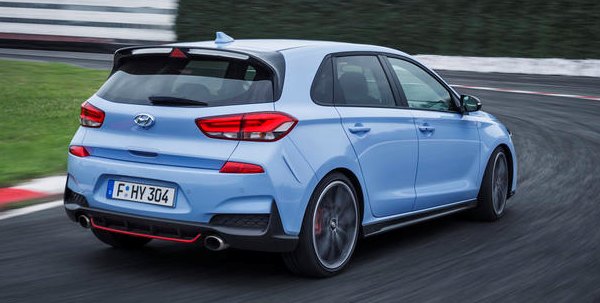
|
|
As
the first fruit of Albert Biermann at Hyundai N, it has established a
respectable baseline.
|
|
Still, on the road you will appreciate the engine’s flexible low-end,
quick throttle response and barely noticeable turbo lag. It will rev to
6600 rpm before cut-out, but frankly it doesn’t need to rev so high.
Its soundtrack is not particularly attractive at the top end either.
That said, every all-out downshift rewards you with pops and crackles
on overrun if you engage the hardcore N mode. Meanwhile, the 6-speed
manual gearbox adds fun with a slick and tactile gearshift, accompanied
with nice pedal placement for heel-and-toe action or an automatic
rev-matching function. Nevertheless, the lack of dual-clutch gearbox
option is an oversight for the car’s market positioning. Hyundai is
developing one that can handle the car’s torque, but it is 2 years away.
The chassis of i30N is reinforced by 3 underbody braces across the
front subframe. The Performance model is additionally fitted with an
electrohydraulic LSD like Golf GTi Performance. It enhances traction
through tight corners and has torque steer and wheel spin kept at bay.
In addition to its bespoke Pirelli P-Zero tires on 19-inch wheels, the
car feels grippy and you can push it quite hard with confidence. The
Performance car also features adaptive dampers. Biermann’s team did a
great job on the suspension tuning, resulting in a European-style firm
but livable ride and good body control. Its steering is precise, fast
(just 2.2 turns from lock to lock) but not nervous. Unlike many
electric steering systems, it feels responsive just off center, giving
you a stronger sense of connection to the road.
However, as good as the work of Biermann, you can’t help feeling the
i30N is slightly handicapped by its weight. It feels more nose-heavy
than Golf GTi and especially 308GTi. Turn-in is not quite as sharp. The
chassis tuning is also more biased towards the safe side, with little
hint of lift-off oversteer to play with. The larger brakes are
dependable, but without a more adjustable chassis balance the i30N is
not going to be a trackday weapon like the old Renault Megane RS.
Factoring in its ordinary interior – the bucket seats are the only
noticeable differences, yet they look cheap – and a slightly boring
shape, it will have its work cut out to persuade hot hatch buyers
shifting from European brands. As the first fruit of Albert Biermann at
Hyundai N, however, it has established a respectable baseline.
|
Verdict:     |
|